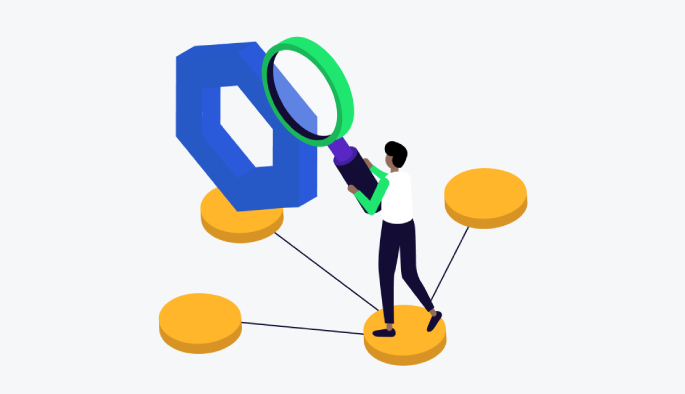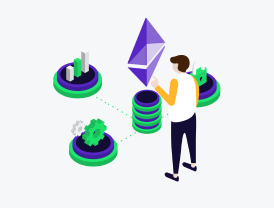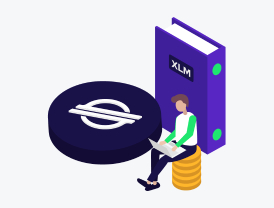What Is Chainlink?
In order to understand Chainlink and its role in the blockchain ecosystem, we first must take a few first steps back to understand the problems and difficulties it was created to solve. Nothing in the web3 world is created in a vacuum, and Chainlink is no different. To accurately understand Chainlink’s origin story, we must first begin with smart contracts.
Smart contracts have been one of the more innovative aspects of the blockchain ecosystem. They’ve allowed anonymous parties to carry out transactions and agreements without the need for an intermediary, legal system, or external enforcement mechanism, thus, cutting out any fees owed to these third parties while promoting frictionless transactions.
But in the few years following their implementation in the modern blockchain world, smart contracts had been operating shorthanded. Applications can only produce high-quality results with high-quality data, and yet, that is exactly what smart contracts were missing. Prior to Chainlink, smart contracts didn’t have the ability to access off-chain data, which means that smart contracts were limited in their capabilities and functionality.
Without the ability to safely access off-chain data, smart contracts were relegated to a relatively limited universe of tokenization mechanism transactions. These types of transactions mainly related to moving tokens, generating tokens, accepting signatures, and combining signatures, as smart contracts were only able to access data that was sitting on that particular blockchain.
This is where Chainlink enters the picture. In short, the Chainlink network is a decentralized oracle network connecting various protocols, data silos, and smart contracts across numerous blockchain networks. The technology serves to “link” data across each of these “blockchains” or networks. This system allows these networks to communicate with each other to find, share, and store information that didn’t originate on their individual platforms. This allows smart contracts to access real-world data, such as the score of a professional baseball game or the weather. Before Chainklink, smart contracts didn’t have a way to securely access off-chain data.
Chainlink has also created their own digital asset native to the blockchain, called LINK. The LINK token is used in the Chainlink network to compensate Chainlink Node operators for the retrieval of data from the external data sources, turning it to blockchain readable format, off-chain computation, and uptime guarantees.

What is Chainlink?
As we mentioned, there’s Chainlink and LINK. Chainlink refers to the blockchain network and LINK refers to the actual digital currency that is represented by the LINK token.
Launched in June 2017, Chainlink was developed by SmartContract.com, a company co-founded by Sergey Nazarov and Steve Ellis. Chainlink is an Ethereum-based network and is secured by a proof-of-stake mechanism.
As we mentioned earlier, Chainlink is a decentralized network of oracles that provide data from off-chain sources to on-chain sources, and vice versa. The network allows smart contracts to access real-world information and data that exist outside of the blockchain in a secure manner.
It connects various protocols, data silos, and smart contracts across numerous blockchain networks, serving to link data across each of these networks. Chainlink’s objective is to remove and replace all the “middlemen” who were, at one point, responsible for transferring all of this data, in order to make this process more efficient and secure.
What is LINK?
Serving as Chainlink’s native digital asset, LINK is an ERC-677 token built on top of the Ethereum blockchain. The LINK token is used in the Chainlink network to compensate Chainlink Node operators for the retrieval of data from the external data sources, turning it to blockchain readable format, off-chain computation, and uptime guarantees. There was a supply of 1 billion LINK Tokens created, with a little more than 467 million currently in circulation as of the writing of this guide.
For smart contracts to use a Chainlink node, the requesting smart contract service provider must pay the Chainlink node operator with LINK tokens. LINK fees are set by node operators and based on the demand, quality, and type of service they provide.
Node operators also stake LINK — much like providing a security deposit — to demonstrate their commitment to the health of the network and to providing exceptional service. Chainlink’s reputation system also takes into account the size of a node’s stake in the network when it recommends certain nodes for specific jobs.
Though Chainlink nodes receive LINK tokens in return for their services, they can also be taxed, or penalized in LINK for providing faulty or dishonest information. This overall system of rewards and punishments helps keep the decentralized oracle network on track as a reliable source of high-quality information, and enables Chainlink’s integration with several prominent blockchains.
How does Chainlink work?
Chainlink focuses on providing a decentralized oracle network for smart contracts that need secure and reliable connections to real-world data from outside a blockchain network. Because smart contracts can be developed on many different blockchain platforms, Chainlink itself is inherently blockchain-agnostic. At its core, Chainlink does not prefer one blockchain to another, and does not include any features to make it easier for developers to build exclusively on a certain blockchain.
Initially, Chainlink was built to connect with the Bitcoin, HyperLedger, and Ethereum blockchains because they already had a good deal of support and integration with large businesses and institutions. The Ethereum blockchain is also widely considered the current gold standard for programmability, which is vital to the development of smart contracts — one of the key areas where oracles provide value to a blockchain. Chainlink is continuing to build external adaptors to facilitate interoperability with all blockchains.
In parallel, Chainlink is also building out functionality to integrate with a wider variety of data sources by becoming increasingly interoperable with a growing number of application programming interfaces (APIs) representing real-world data feeds. Only a minimal amount of coding is required to make an existing API Chainlink-friendly. Once optimized for Chainlink, an API can provide data to smart contract requests through Chainlink’s oracle system. The specialized adapters that Chainlink requires have been designed for easy setup in any programming language, which increases accessibility to data providers.
Chainlink also offers significant support and resources for software developers on both the client and data-provider sides. Chainlink wants to make it easy to connect smart contract developers with APIs that they are already familiar with; it also aims to provide opportunities for data providers — who can generate revenue from smart contract requests once their APIs become Chainlink-compatible. Chainlink is blockchain-agnostic; it allows data providers to sell their services to projects that operate on any blockchain network. Overall, Chainlink maintains an active role in building and maintaining productive interactions between smart contract developers and the data they need.
What is an oracle network?
The accuracy and reliability of smart contracts rely heavily on the quality of data that they use to execute their terms. When off-chain data is needed, oracles are critical for smart contracts’ accuracy. Centralized oracles are controlled by a singular entity. Acting as the sole provider of data for a smart contract, centralized oracles require network participants to place a significant amount of trust in the validity of their data. They also represent a single point of failure, which threatens the very security and trustlessness that a smart contract is supposed to have. Many oracle experts contend that a centralized oracle can be more easily corrupted and disrupted than a decentralized oracle. Either way, if an oracle or its data is compromised, so is the smart contract.
Decentralized oracles aim to achieve deterministic, transparent results in the same way that a blockchain network does: by distributing trust among numerous participants. With different data sources, these oracle systems aren’t controlled by a single entity. Decentralized oracle networks (DONs) provide increased security and transparency, which drastically improves smart contract usability.
Chainlink’s oracle network works to increase the reliability and security of the blockchain architecture it is meant to optimize. This effort is illustrated by Chainlink’s open-source and decentralized nature, which allows anyone in the blockchain community to independently verify the Chainlink source code and contribute to its development and improvement. The Chainlink crypto network is also decentralized, which ensures that there is no potential for a single point of failure. In contrast to a centralized oracle, Chainlink’s oracle system verifies data across myriad nodes — so even if one or more nodes is compromised, the network will correct itself as long as the uncompromised nodes maintain a majority.
Customization and end-to-end security are paramount for reliable oracle data delivery. With this in mind, Chainlink nodes give smart contracts the ability to connect to any application programming interface (API), which drastically increases the system’s security and flexibility. Individual nodes can securely store account logins and API keys, which allows smart contracts to receive data from any external source or API, including those that are password protected.
By simplifying how smart contracts communicate with external data, Chainlink’s mission is to expedite the development of more advanced smart contract use cases. This allows software engineers to allocate more effort toward developing state-of-the-art smart contracts with increasing levels of sophistication.
What is Chainlink’s mission?
For several years, smart contracts were limited in their capacity — they were confined to dealing with items or transactions that used data and information contained on the specific blockchain in which the smart contract was being used. It was impossible to create a smart contract that needed data from multiple blockchains or real-world information.
Chainlink’s objective is to create a decentralized oracle network connecting various protocols, data silos, and smart contracts across numerous blockchain networks. This system allows these networks to communicate with each other to find, share, and store information that didn’t originate on their individual platforms. Now, using Chainlink, smart contracts can access real-world data, or off-chain data, in a quick and secure manner. This allows smart contracts to be used for a much wider range of transactions.




